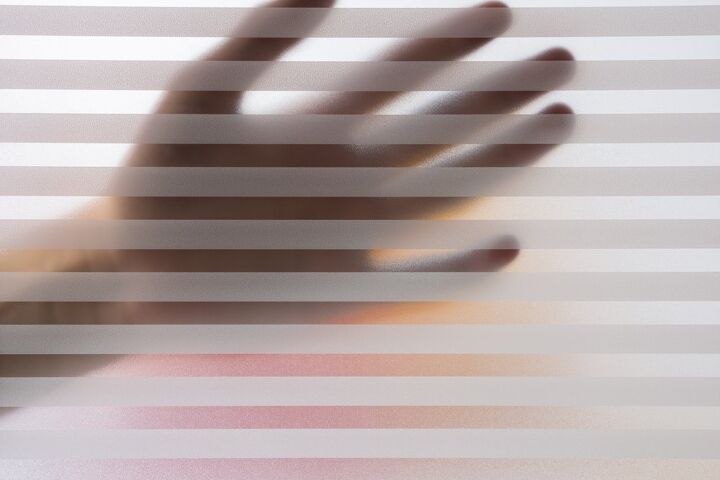Does Privacy Film Work At Night?

During the day, many people have difficulty working, knowing that people are watching them. Privacy window film is a great solution for just this problem.
On one side of the privacy film, you can see the world outside and enjoy the sunlight, typically without the harmful UV rays. On the other, it is typically nearly opaque or like a mirror. Does this work at night, though?
Some types of window privacy film can work at night if it is opaque enough to block light constantly. You can enhance your privacy film and the one-way glass effect with a 1:3 exterior lighting ratio at night. Electronic window film is the only option that works consistently well 24 hours a day.
This article will talk about the different types of privacy films so you can decide which is the best for you.
Do You Need Window Tinting Services?
Get free, zero-commitment quotes from pro contractors near you.

Will One Way Mirror Film Double As Privacy Film?
One-way mirror film is essentially a partially opaque mirror. When you look at a mirror, it is reflecting the light in the room back at you. A one-way mirror film is doing the same thing reflecting the light around you into your eyes.
During the daytime, if you look at a privacy filmed window from the outside, it reflects the surroundings. However, suppose you look at this scene from inside the house. In that case, the window is mostly transparent because the light is coming from the outside, not the dim interior.
This same property works with untreated glass due to its slight reflectivity as well, just not near as efficiently. However, at night, the situation is reversed because the house is lit by artificial light, and the outside is dark. This means people on the outside will be able to see in, but you will not be able to see out.
What Are The Different Types Of Privacy Window Film?
Whether privacy film works at night or not depends on the type that you use. Here are some different types of privacy window film below.
Dual Reflective Film
The dual reflective film offers the same metallic protective qualities as mirror film. This is enhanced by the presence of a slight tint on the inside surface of your window. This film often removes approximately 5% of the light coming from your home.
This type of film enhances your ability to see out. It also lowers the amount of light that needs to be present outside relative to that inside.
Common ratios of light outside to inside for this reflective property to work are 1:4 for standard one-way window film. The ratio is 1:3 for dual-reflective window film.
Exterior Lighting
If you wish to use one-way glass, you may be wondering if you can use exterior lights to make it work. Just remember that the lighting would have to achieve at least a 1:3 ratio to make it work like during the day. This is difficult to achieve and often unfeasible.
Frosted Glass Film
Frosted glass is an attractive option for someone that wants a limited degree of privacy. The glass is translucent, so it provides some privacy, but offers less privacy than blinds.
It works by distorting the lights passing through it. This makes the image unclear but still visible. Another feature some frosted glass varieties have is the ability to be pulled off at will which is a significant advantage.
Opaque Glass Film
Opaque glass film is just that opaque. Its advantage is that no one will see through your windows, although, unfortunately, that includes yourself. Additionally, you can purchase many different designs, including many colors and even pictures.
One interesting detail of these is that they allow you to determine how much light you want to come through the window. In particular, opaque films come in varieties that enable most light to pass through to “blackout” varieties that allow none.
Depending on your choice you may want to consider “daylight” interior lighting to compensate for the lesser natural lighting
Electronic Window Film
Electronic window film is slightly different than the others because it needs to be wired in. When an electric current is passed through, this window film is transparent, and anyone can see through it. When the current is turned off, it becomes opaque.
This can provide a unique level of choice when you want privacy or an open view. This also works 24/7, so it is a great choice for privacy at night.
How Do You Apply Window Film?
If you wish to apply window film, most types follow the same procedures. However, remember electronic window film requires wiring and the steps for this vary. So look at your manufacturer’s instructions before trying to install; for most follow these steps:
- Clean your window: You need a special film application cleaner or water and a slight amount of baby shampoo. The reason for this is that most cleaners have chemicals that would damage your tint.
- Gently scrape your windows: Take a flat razor while damp. Spray down the window again. Dry it with a squeegee and microfiber cloth.
- Cut your film: Make it 1/2″ to 1″ larger than your window.
- Spray your window: Use the cleaner from earlier and stick your film onto the window.
- Use a squeegee: Work the bubbles out from the center and force them out of the edges.
- Now trim your window film: Make it fit perfectly into your frame with a utility knife. Be careful not to damage your glass.
How Do You Remove Window Film?
Messed up on the previous process? Perhaps you just have an old window film you want to remove. Either way, it’s not hard to remove window film. Just follow these steps:
- Spray vinegar or ammonia: Remember how many cleaners damage tint? Ammonia is one of these. These cleaners dissolve the adhesive that keeps tint on.
- Apply plastic wrap: Plastic wrap will trap the ammonia in place to give it time to dissolve. Do not breathe the ammonia fumes! Wait overnight! Make sure to ventilate if you are using ammonia as the fumes can be dangerous. Also, make sure the plastic wrap is keeping the moisture in place; otherwise, you will need to respray as necessary.
- Use a razor and peel: Using a flat razor, peel back a corner and pull the tint off. Often, it will rip, forcing you to repeat strip by strip.
- Clean the window: Use the ammonia again and clean with a flat razor and microfiber cloth to remove all the adhesive.
Are There Alternatives To Privacy Window Film?
If the lack of one-way privacy film for nighttime is a dealbreaker, consider these other options.
- Curtains: Curtains come in many varieties and can complement other options and are often cheap and easy to install. By using one-way film during the day, you can complement them with curtains at night.
- Sheer curtains: These Curtains deserve a standout mention. They can offer most of the benefits of frosted glass by distorting images. You can also simply slide a sheer or semi-sheer curtain aside whenever you want to see clearly.
- Shutters: Shutters are an old fashioned solution, but they have some compelling advantages. They offer security, storm resistance, insulation, and unparalleled privacy. Often, there is nothing like a solid opaque barrier to enhance your privacy.
How Do You Clean Your Window Film Properly?
Window film often makes for a softer, more delicate surface than glass. Also, you frequently have to avoid damaging the adhesive. To do this, use a mild cleaner without ammonia, diluted dish detergent and white vinegar will do fine.
Clean by spraying your window down and dry with a squeegee and microfiber cloth. Avoid scratching your windows; only use gentle tools like those listed. Also, wait to clean for at least 30 days after applying the window film.
Related Questions
Why are my double pane windows cloudy?
When you have double pane windows, they usually have air or argon that is trapped between both panes of glass which helps keep the window insulated which means that you don’t lose as much heat.
So, if your double pane window looks like it’s foggy or misty then your seal protecting gases are failing and you’ll need to get that fixed or replace the window as a whole.
Is there a window film that works at night?
Blackout films help to ensure that nobody can see through your window whether it’s night or daytime. this window will help it to where it’s completely dark on the outside when someone is looking in from the outside. It’ll be even darker when it’s night time.
Can you see through mirrored window film at night?
No, you cannot see through the mirrored window film at night as long as the inside of your home is also dark. If you have lights on, then they’ll be able to see inside of your house.
However, during the daylight, you can see through mirrored windows as well so if you’re looking for something that helps keep your window from being able to be seen through during any time of day, you’ll want blackout film.
Do You Need Window Tinting Services?
Get free, zero-commitment quotes from pro contractors near you.

Wrapping It Up
In this day and age, privacy film is almost always necessary to feel safe and secure inside of your home, especially at night time. Therefore it is important to know which privacy film you should choose as there are different types.
If you’re looking for something that keeps your windows black throughout the day and night, you will want blackout film. We hope this article was helpful!

I am a writer who enjoys working on home improvement projects. My husband was in the navy, so we moved frequently. This gave me many opportunities to fix up new places. In my spare time, I enjoy reading mysteries and hiking.
More by Lisa Borga



























